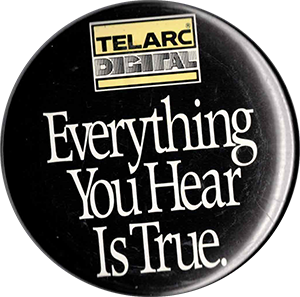Telarc and the Development of Audio Technology
Telarc was formed at the start of the digital recording era and demonstrated the sonic potential of this new technology. Their alliance with Soundstream in this effort was the first of numerous partnerships with equipment makers and tinkerers. These early days set the tone for Telarc’s leadership in the technical side of recording. This part of the Telarc story is recorded primarily in two places: the pages of audio magazines (discussed below) and the inside back cover of their CD booklets (click here for an example of a detailed listing).
Last updated on April 16th, 2024 at 03:24 pm
- Greg Milner, Perfecting Sound Forever : An Aural History of Recorded Music, (New York: Faber and Faber, 2010), p 309 ↩︎
- See “A Day at the Opera,” Studio Sound, October 1991 and “Recording Liza Minnelli: The Challenge,” db Magazine, June 6, 1988. ↩︎
- These profiles appeared in magazines such as Stereophile (Jack Renner with Jonathan Scull), Studio Sound (Jack Renner with Janet Angus), TapeOp (Michael Bishop with David Goggin), and the Inner Circle podcast (Michael Bishop with Bobby Owsinski). ↩︎
- Session guests included John LaGrou (Millennia Media), Ed Meitner (EMM Labs), Mark Levinson, John Ötvös (Waveform), and others. ↩︎
- The Woods/Martone private collection and the Thomas Stockham papers at the University of Utah contain this documentation. ↩︎
- Bishop discusses some of these experiments in this interview. ↩︎
- These systems were Pro-Spatiailzer, Dolby Surround, Shure HTS, and Circle Surround. They each in their own way mimicked how sound changes as it reaches the ear from different directions. ↩︎
- Joe Saltzmann, “Compact Disc: Too True To Be Good?” Los Angeles Times, November 27, 1983 ↩︎
- Bert Whyte, et. al., “Brandenburgs Rare,” Audio, February 1984, 90 ↩︎
- Leonard Feldman, “Technics SL-P8 review”, Audio , April 1984, 55 ↩︎
- Jack Schofield, “No Taste for High-Quality Audio,” The Guardian, August 2, 2007. ↩︎
- “Telarc: Still on Digital’s Leading Edge,” Mix Magazine, December 1998, p. 169 ↩︎
